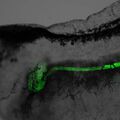Fluorescent In-Situs and FCIS (Vize lab): Difference between revisions
imported>Xenbase No edit summary |
No edit summary |
||
| (8 intermediate revisions by 2 users not shown) | |||
| Line 1: | Line 1: | ||
These pages contain protocols for performing wholemount fluorescent in situs. Instructions for two-color FISH and for a combination of fluorescent and colorimetric in situs we have called FCIS. Data can be imaged with a fluorescence stereoscope or a confocal. | These pages contain protocols for performing wholemount fluorescent in situs. Instructions for two-color FISH and for a combination of fluorescent and colorimetric in situs we have called FCIS. Data can be imaged with a fluorescence stereoscope or a confocal. | ||
*FISH protocol | *[[FISH_/_Double_FISH|FISH protocol]] | ||
*Fluorescein tyramide synthesis | *[[Flourescin_Tyramide_Synthesis|Fluorescein tyramide synthesis]] | ||
*Cy3 tyramide synthesis | *[[Cy3_Tyramide_Synthesis|Cy3 tyramide synthesis]] | ||
*FCIS protocol | *[[FCIS|FCIS protocol]] | ||
FISH is not as sensitive as standard BM purple in situs, so if you have a very low abundance message it may not be detectable via fluorescence. You can however do a normal purple development for your low expression gene and a fluorescent counterstain- then overlay them to generate a FCIS image. These are both pretty and very good at highlighting quite subtle overlap | FISH is not as sensitive as standard BM purple in situs, so if you have a very low abundance message it may not be detectable via fluorescence. You can however do a normal purple development for your low expression gene and a fluorescent counterstain- then overlay them to generate a FCIS image. These are both pretty and very good at highlighting quite subtle overlap | ||
'''Images:''' | |||
<gallery> | |||
File:33ffar.jpg|FISH, Fluorescein | |||
File:2876.jpg|FCIS; fluorescent and colorimetric in situ | |||
File:38-doubleFISH-big.jpg|Double FISH, Fluorescein and Cy3 | |||
File:frog10x-big.jpg|FISH plus transmitted light | |||
</gallery> | |||
'''Papers and other sites:''' | '''Papers and other sites:''' | ||
| Line 18: | Line 20: | ||
[http://www.faculty.virginia.edu/davidson/fluor_insitu/fluorescent_in_situ.html| Lance Davidson's flourescent in situ methods page] | [http://www.faculty.virginia.edu/davidson/fluor_insitu/fluorescent_in_situ.html| Lance Davidson's flourescent in situ methods page] | ||
Vize, P.D., McCoy, K.E., and Zhou, X. (2009). Multichannel wholemount fluorescent and fluorescent/chromogenic in situ hybridization in Xenopus embryos. [http://www.ncbi.nlm.nih.gov/pubmed/19498377| Nat Protoc. 4(6): 975-983.] | |||
Latest revision as of 11:10, 12 June 2012
These pages contain protocols for performing wholemount fluorescent in situs. Instructions for two-color FISH and for a combination of fluorescent and colorimetric in situs we have called FCIS. Data can be imaged with a fluorescence stereoscope or a confocal.
FISH is not as sensitive as standard BM purple in situs, so if you have a very low abundance message it may not be detectable via fluorescence. You can however do a normal purple development for your low expression gene and a fluorescent counterstain- then overlay them to generate a FCIS image. These are both pretty and very good at highlighting quite subtle overlap
Images:
-
FISH, Fluorescein
-
FCIS; fluorescent and colorimetric in situ
-
Double FISH, Fluorescein and Cy3
-
FISH plus transmitted light
Papers and other sites:
Zhou, X. and Vize, P.D. (2004). Proximo-distal specialization of epithelial transport processes within the Xenopus pronephric tubules. Developmental Biology 271: 322-338.
Lance Davidson's flourescent in situ methods page
Vize, P.D., McCoy, K.E., and Zhou, X. (2009). Multichannel wholemount fluorescent and fluorescent/chromogenic in situ hybridization in Xenopus embryos. Nat Protoc. 4(6): 975-983.



